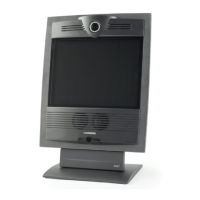
Do you have a question about the TANDBERG 1000 and is the answer not in the manual?
| Frame Rate | Up to 30 fps |
|---|---|
| Audio Standards | G.711, G.722, G.728 |
| Network | IP |
| Data Ports | RS-232 |
| Operating Voltage | 100-240 VAC |
Safety guidelines and precautions to follow before and during the installation process.
Instructions for connecting the power and network cables to the videoconferencing system.
Steps for configuring the system after initial setup, including network and system names.
Detailed settings for configuring ISDN network connections and parameters.
Detailed settings for configuring Local Area Network (LAN) connections.
Procedure for powering on the system and initial readiness checks.
Description of the initial system menu, displaying key information and options.
Explanation of the primary function buttons on the remote control.
Keys for controlling the camera and navigating the system menus.
Step-by-step guide for initiating and terminating video calls.
How to use and manage the system's local phone book for contacts.
Instructions for adjusting the system's audio volume levels.
How to display your own outgoing video feed on the monitor.
How to mute and unmute the microphone during calls.
Managing the system's speaker output and audio redirection.
Explanation of the various icons and symbols displayed on the system interface.
Features for managing incoming calls and reducing power consumption.
Operations for controlling the primary camera's pan, tilt, and zoom.
Choosing which video input to transmit to the far end.
Storing and recalling predefined camera positions and settings.
Functionality for displaying PC images and content on the system.
Controlling the camera of the remote participant.
Capturing and viewing still images during a conference.
Managing multipoint conferences when connected to an external MCU.
How to access and manage the system remotely via a web browser.
Using the system for data transfer and application sharing via T.120.
Overview of accessing and navigating the system's main menu.
Setting a password to restrict access to system menus.
Selecting and optimizing audio and video quality for calls.
Accessing various system management and diagnostic tools.
Basic network setup for the system, including ISDN and LAN parameters.
Configuration specific to ISDN Basic Rate Interface connections.
Choosing the correct type of ISDN network connected to the unit.
Programming the telephone numbers associated with ISDN lines.
Detailed configuration settings for ISDN subaddressing and numbering.
Configuration parameters for connecting to a Local Area Network.
Settings for enabling and managing audio/video streaming.
Configuration options for the H.323 videoconferencing protocol.
Advanced configurations for H.323, including RSVP, NAT, and QoS.
Configuration of IP addressing, subnet mask, and gateway.
Configuration parameters for connecting to a wireless network.
Settings for encrypting the wireless LAN connection for security.
Configuration for Simple Network Management Protocol (SNMP) monitoring.
Customization of audio alerts, tones, and volume levels.
Configuration for remote system access using Virtual Network Computing (VNC).
Configuring call handling, such as incoming calls and access codes.
Enabling and configuring AES and DES encryption for secure calls.
Setting automatic limits for call duration to manage usage.
Defining and managing network connection profiles for calls.
Settings for connecting a PC to the system's serial (RS232) port.
Choosing the preferred language for the system's on-screen menus.
Using option keys to activate features like Security and Presenter.
Tools for testing system components and viewing current settings.
Displaying detailed information about the status of active calls.
Resetting system settings to their original factory default values.
Performing tests on different subsystems of the videoconferencing equipment.
Description of the available connectors for peripheral devices.
Instructions for connecting and using a document camera with the system.
Using a Kensington Lock to secure the videoconferencing unit.
Connecting PCs for data transfer and application sharing.
Using PC SoftPresenter to display images from a connected computer.
Details on access codes and menu password protection for system security.
Instructions for accessing and managing system files using FTP.
Regulatory compliance information and harmonized standards applied.